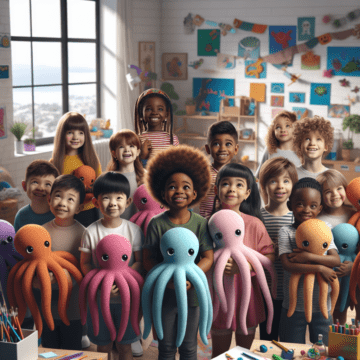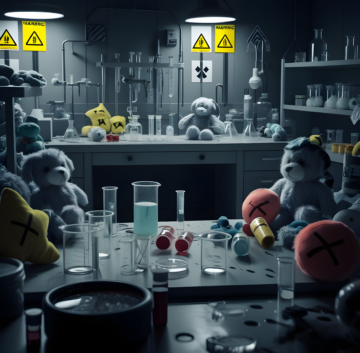
Parents everywhere understand the joy and comfort that plush toys can bring to their little ones. However, few are aware of the potential chemical hazards lurking within their children’s cuddly companions. This article, ‘Chemical Hazards in Plush Toys: What Manufacturers Don’t Tell You’, aims to shed light on the often-overlooked topic of toy safety, with a particular focus on the hidden dangers that can be found in plush toys. Whether it’s concerning the materials used, the dyes applied, or the flame retardants embedded, we’ll delve deep into what you should be aware of when buying these seemingly innocent playthings. By educating ourselves about the potential risks and the chemicals to avoid, we can ensure the toys we bring home are not only fun, but safe for our children. So, if you’ve ever wondered about the safety standards of plush toys, toy manufacturing processes, or the potential health risks associated with toy chemicals, this eye-opening read is for you. Let’s explore the lesser-known aspects of toy safety together, for the wellbeing of our kids.
- 1. Understanding the Hidden Dangers: Chemicals Lurking in Plush Toys
- 2. Potential Health Risks: Impact of Toxic Chemicals in Soft Toys on Children
- 3. Regulatory Overview: Laws Governing Chemical Use in Toy Manufacturing
- 4. Decoding Labels: Identifying Harmful Substances in Your Child’s Plush Toys
- 5. Safer Alternatives: Choosing Low-Chemical Plush Toys for Your Kids
1. Understanding the Hidden Dangers: Chemicals Lurking in Plush Toys
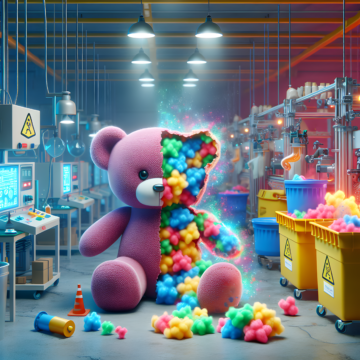
Exposing the unseen threats, it’s crucial to delve into the depths of potentially harmful substances that may be embedded in your child’s favorite plush toys. Unbeknownst to many, these adorable, cuddly playthings can harbor a range of chemicals that pose significant health risks. For instance, synthetic dyes and flame retardants used to produce vibrant colors and safety features, respectively, are often loaded with hazardous compounds such as lead and phthalates. These toxins, linked to a variety of health issues like developmental delays, allergies, and even cancer, are alarmingly prevalent in many mass-produced plush toys. Manufacturers, prioritizing cost-efficiency and aesthetics, often refrain from revealing these hidden dangers. The lack of regulations and transparency in the toy industry further exacerbates the issue. As responsible consumers and caregivers, it’s vital to educate ourselves about toy safety standards, scrutinize product labels, and opt for organic, non-toxic alternatives whenever possible. Remember, safeguarding our children’s health starts with informed choices.
2. Potential Health Risks: Impact of Toxic Chemicals in Soft Toys on Children
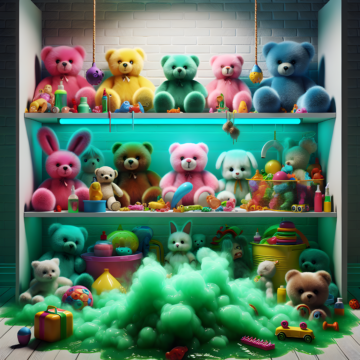
Children’s safety is paramount, and an area of concern that often goes unnoticed is the presence of toxic chemicals in soft toys. Many of these plush companions, adored by little ones, unfortunately contain harmful substances that pose potential health risks. These substances can range from lead, phthalates, brominated flame retardants (BFRs), to volatile organic compounds (VOCs), which are used in the manufacturing process to enhance durability, flexibility, and color. Prolonged exposure to these chemicals can lead to a myriad of health issues, including hormonal disturbances, developmental delays, and even increased risk of cancer. Alarmingly, children can ingest these toxic chemicals not only by chewing on their toys but also through skin absorption. This revelation about the hidden dangers lurking in cuddly toys underscores the importance of advocating for stricter safety regulations in toy manufacturing and promoting awareness among parents and caregivers about the potential health hazards associated with these beloved playthings. The wellbeing of our children is at stake, necessitating a concerted effort to ensure the toys they cuddle and play with are free from toxic compounds.
3. Regulatory Overview: Laws Governing Chemical Use in Toy Manufacturing
Unveiling the legal boundaries that govern the use of chemicals in toy production is fundamental not just for manufacturers, but also for parents and guardians who need to know what their children are exposed to. Globally, there are stringent standards and regulations in place to ensure that toymakers adhere to safe practices, minimizing the risk of chemical hazards in plush toys and other playthings. In the United States, for example, the Consumer Product Safety Improvement Act (CPSIA) and regulations by the Consumer Product Safety Commission (CPSC) are designed to limit the use of certain harmful substances in toys. These include lead, phthalates, and other potentially toxic chemicals. In Europe, the EN71 standard, set by the European Committee for Standardization, regulates toy safety, including chemical use. These laws are instrumental in protecting our children from hidden dangers in their favorite playthings, but it’s equally important to remember that enforcement and adherence can vary. Therefore, parents and caregivers should always remain vigilant, choosing toys from reputable manufacturers who prioritize safety in their production processes.
4. Decoding Labels: Identifying Harmful Substances in Your Child’s Plush Toys
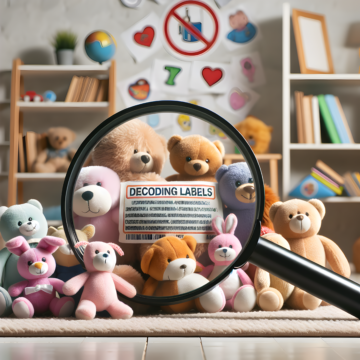
As parents, the safety of our children is always a top priority. Ensuring this extends to their toys, particularly plush toys, is crucial. Hidden dangers might lurk in the form of harmful substances within these seemingly innocent playthings. Unveiling these hazards begins with understanding and decoding labels on your child’s plush toys. Manufacturers often use complex terms to describe materials and substances used in toy production, which can make it challenging to identify potential risks. The key is in understanding these terms and being able to spot harmful substances such as phthalates, lead, brominated flame retardants (BFRs), and formaldehyde. These chemicals have been linked to health issues ranging from allergies to more severe conditions like hormone disruption and neurodevelopmental disorders. By becoming informed and vigilant, you can better protect your children from these hidden chemical hazards. Remember, knowledge is power, especially when it comes to ensuring the safety of your little ones.
5. Safer Alternatives: Choosing Low-Chemical Plush Toys for Your Kids
Unveiling the hidden truth about the hidden chemical hazards in your child’s favorite plush toys can be a startling revelation. It’s alarming to discover that these cuddly companions can potentially harbor toxins detrimental to your child’s health. Thankfully, there are safer alternatives available. Parents can make conscious decisions to select low-chemical plush toys, ensuring their children’s playtime remains safe and wholesome. Low-chemical plush toys are crafted with organic, non-toxic materials that pose no harm to your child or the environment. These toys are often colored with natural dyes, reducing exposure to harmful synthetic pigments. Opting for plush toys with certifications such as OEKO-TEX® or GOTS ensures they are free from a myriad of harmful chemicals and are safe for your child. By choosing low-chemical plush toys, you not only protect your child’s health but also contribute to a more sustainable future. Ensure to read labels, ask questions, and research brands when purchasing plush toys, as your child’s safety and well-being are priceless.
Conclusion
In conclusion, our examination of the ‘Chemical Hazards in Plush Toys: What Manufacturers Don’t Tell You’ has given us a startling insight into the hidden dangers that may lurk within seemingly harmless children’s playthings. The purpose of this article was not to scare parents or caregivers but to shed light on the potential risks associated with certain toys, emphasizing the importance of a keen eye and informed choices when it comes to children’s toys.
We’ve discussed the harmful substances that might be present in plush toys, such as lead, phthalates, and brominated flame retardants. These chemicals are not only potential allergens that can cause skin reactions, but they are also toxic, posing risks to a child’s nervous system, hormonal balance, and overall development.
We examined how these chemicals come to be in the toys. They are often found in the dyes used to color the plush toys, the plasticizers that make the toys flexible, and the flame retardants that are supposed to make these toys safe. It is ironic, and somewhat disconcerting, that measures taken to make the toys safe are, in fact, introducing another form of danger.
Importantly, we also talked about the regulations, or lack thereof, that monitor the use of these chemicals in toy manufacturing. While some countries have stringent measures in place, others do not, leading to a discrepancy in safety standards worldwide. Furthermore, enforcement of these regulations is another challenge altogether.
Finally, we provided some strategies to mitigate the risks associated with these chemical hazards. Choosing toys certified by trusted organizations, washing plush toys regularly, and avoiding toys with a strong chemical smell can all contribute to reducing the exposure of children to these harmful substances.
In the end, it is crucial that we continue to demand transparency and safety from manufacturers. While it’s true that not all plush toys are hazardous, awareness about the potential chemical dangers in some toys can empower consumers to make safer choices. The health and well-being of our children should always be a priority, and it starts with us being well-informed.
So next time you pick up a plush toy, remember to look beyond its cuddly exterior. The true measure of a toy’s safety isn’t just about the absence of sharp edges or small parts, but also the hidden chemical dangers it may harbor. Let’s strive to ensure that our children’s playtime is as safe as it is fun.
